Living fences use native shrubs, trees, and vines as natural alternatives to traditional barriers. Unlike conventional fences, these living boundaries provide food and shelter for wildlife while supporting local ecosystems. You’ll enjoy reduced maintenance costs, enhanced property aesthetics, and increased biodiversity with strategically selected plants. By creating layered habitats with flowering and fruiting species, you’re establishing wildlife corridors that connect fragmented landscapes. The journey from planning to maintaining these ecological borders reveals benefits for both you and nature.
What Makes a Living Fence Different From Traditional Barriers

How often have we overlooked the humble fence as merely a boundary marker? While traditional fences made of wood, metal, or stone serve their basic purpose, they can disrupt ecosystems and hinder wildlife movement.
A living fence, by contrast, consists of carefully planted shrubs, trees, or vines that grow together to form a natural barrier. You’ll find these green boundaries offer far more than simple property division. They provide habitat and food for local wildlife while allowing safe passage for various species, supporting migration patterns and promoting biodiversity.
Once established, your living fence requires minimal maintenance compared to conventional options, yet continuously delivers ecological benefits.
Plus, you’ll enjoy the ever-changing seasonal beauty of living fences rather than staring at the same static barrier year-round.
Historical Roots: The Ancient Practice of Natural Boundary Creation
The practice of creating living boundaries stretches back to the dawn of human civilization, far beyond our modern gardening trends. As early as 10,000 BCE, Neolithic farmers recognized the dual benefits of hedgerows for containing livestock and deterring predators, establishing the foundation for living fences as we understand them today.
Ancient Mesopotamians skillfully employed willow fences to protect their fields and prevent soil erosion, demonstrating an early understanding of sustainable land management.
Willow fences served ancient Mesopotamians as both field protection and erosion control—an early glimpse of sustainable agricultural wisdom.
During medieval times, you’d find hedgerows serving as powerful symbols of legal boundaries throughout England’s countryside, where they’ve thrived for over a millennium, supporting diverse wildlife.
The Renaissance elevated these practical barriers to art forms, with elaborate hedge mazes and pleached tree corridors transforming palace gardens into showcases of humanity’s relationship with nature.
Ecological Benefits of Wildlife-Friendly Living Borders

While traditional fencing options create lifeless barriers, wildlife-friendly living borders transform property boundaries into vibrant ecosystems that support local biodiversity. When you plant native species in these borders, you’re providing essential food sources, shelter, and nesting sites for birds, pollinators, and other wildlife.
| Benefit | Ecological Impact |
|---|---|
| Habitat Creation | Supports diverse species throughout seasons |
| Wildlife Movement | Reduces mortality rates and enables natural behaviors |
| Soil Protection | Acts as windbreak, reducing erosion and moisture loss |
Your living fence creates a layered habitat that attracts both migratory and resident wildlife. These natural boundaries contribute to ecosystem stability while offering year-round benefits. By incorporating native plants of varying heights and densities, you’ll develop a dynamic border that thrives alongside local wildlife, enhancing your property’s ecological value.
Selecting Native Plants for Your Regional Ecosystem
Selecting the right native plants forms the foundation of any successful living fence project. When you choose species adapted to your local climate and soil conditions, you’ll create a resilient boundary that requires minimal maintenance while maximizing ecological benefits.
Focus on incorporating a diverse mix of native flowering shrubs like viburnums and elderberries that provide sequential blooms and fruits throughout the year. This succession attracts and sustains wildlife across seasons.
Opt for clumping varieties rather than uniform shapes to mimic natural growth patterns that better support wildlife habitats.
Before purchasing, consult a Native Plant Finder tool to identify species that thrive specifically in your region. This targeted approach guarantees your living fence effectively supports local biodiversity by providing food and shelter for birds, pollinators, and beneficial insects.
Designing a Multi-Layered Structure for Maximum Habitat Value
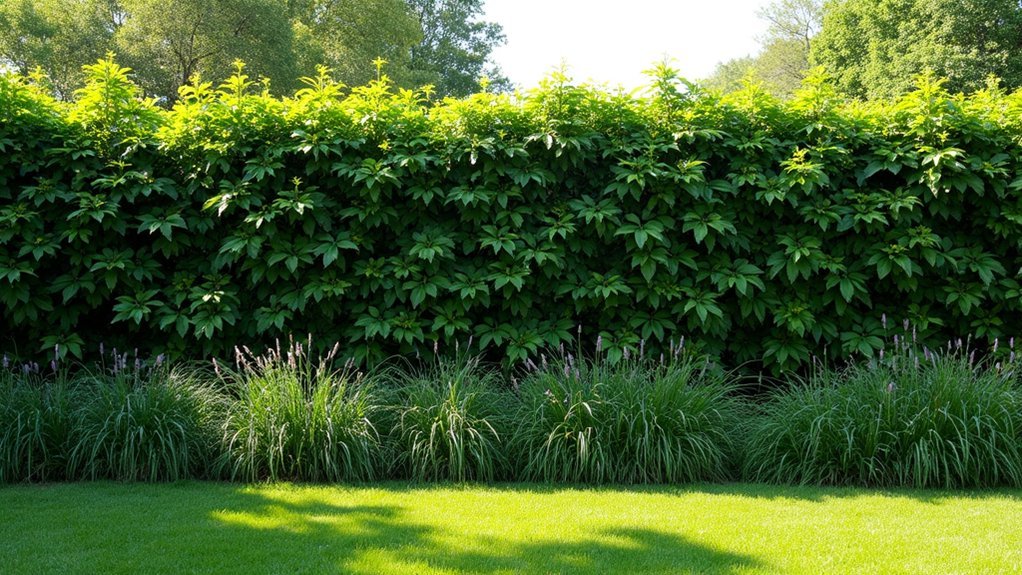
Creating effective wildlife habitat requires thoughtful vertical layering in your living fence design. By strategically combining native trees, shrubs, vines, and ground cover, you’ll provide food and shelter for diverse wildlife throughout the seasons.
- Position taller flowering trees like dogwoods and serviceberries at the back to create a foundation and attract birds with their fruits.
- Plant mid-sized shrubs such as viburnums and elderberries in the middle layer to provide food for pollinators and small mammals.
- Include ground-covering native grasses or low shrubs at the front to protect soil and house beneficial insects.
- Incorporate climbing vines like trumpet honeysuckle along your structure to maximize vertical space and offer additional nectar sources.
Remember to include natural gaps that allow wildlife movement while maintaining staggered blooming periods for year-round ecological support.
Seasonal Planning: When and How to Establish Your Living Fence
You’ll want to plan your living fence during summer months, allowing you to take advantage of fall’s ideal conditions for root establishment.
Prepare your planting site 4-6 weeks before fall by removing competing vegetation and amending soil as needed.
Early autumn planting gives your native trees and shrubs time to develop strong root systems before winter while requiring less watering than spring installations.
Fall Planting Benefits
While many gardeners focus on spring for new plantings, autumn presents the ideal time to establish your living fence.
Fall planting gives roots a chance to develop before winter, creating stronger plants that’ll thrive when spring arrives. Your natural fence will be better positioned to provide privacy and withstand challenges in the coming growing season.
- Reduced stress – Cooler temperatures and increased moisture in September and October minimize transplant shock
- Enhanced growth – Prepared soil with organic matter improves fertility and root establishment
- Immediate benefits – New plantings help control wind erosion even during establishment
- Ecological advantage – Native plants selected in fall support local wildlife through winter and promote biodiversity in your landscape
Spring Preparation Timeline
Although fall planting offers many advantages, a properly executed spring timeline guarantees equally successful living fence establishment when autumn planting isn’t possible.
Begin your planning phase in late winter, selecting native species that will thrive in your specific soil and climate conditions.
By early spring, you’ll want to gather seeds or cuttings of chosen plants like Osage orange or native flowering shrubs.
Plant immediately after the last frost when soil becomes workable, giving your living fence the longest possible growing season before summer heat arrives.
Throughout the first season, maintain consistent watering and apply a generous mulch layer to retain moisture and suppress weeds.
Late summer pruning encourages the bushy, dense growth that makes living fences effective as both wildlife habitat and natural property boundaries.
Supporting Wildlife Through Strategic Plant Selection
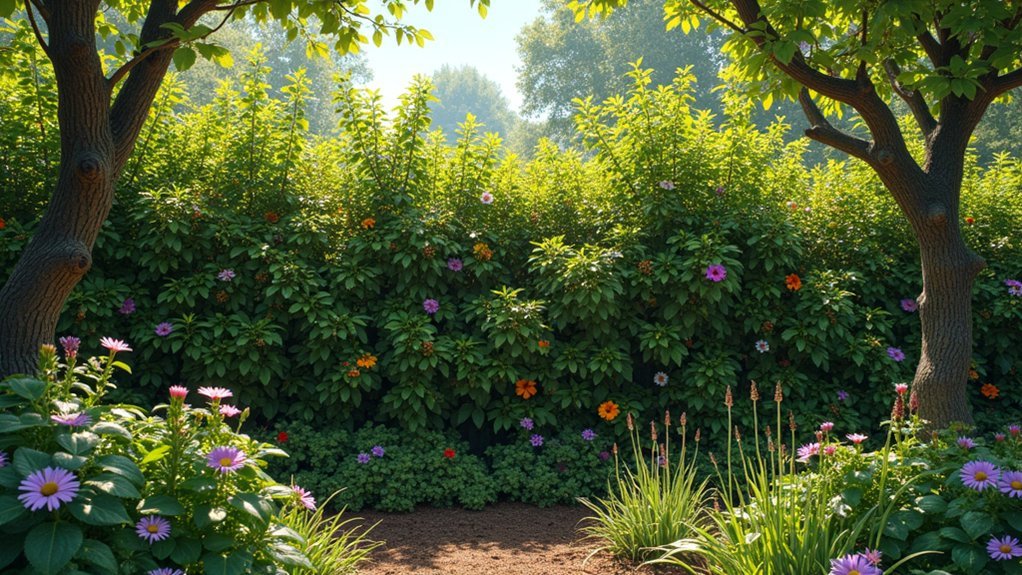
You’ll transform your property into a wildlife haven by choosing native plants like viburnums, elderberries, and native roses for your living fence.
Creating a layered habitat with understory shrubs beneath taller trees provides diverse nesting sites and food sources for birds, pollinators, and small mammals.
Plan your plant selection to guarantee year-round benefits with spring-flowering shrubs, summer fruit producers, and evergreens that offer winter shelter and food when resources are scarce.
Native Plants Matter
When creating a living fence, the selection of native plants serves as the foundation for a thriving ecosystem in your yard.
Native species have evolved alongside local wildlife, forming mutually beneficial relationships that exotic plants simply can’t replicate.
- Climate adaptation – Choose plants adapted to your local environment to reduce maintenance while boosting ecological resilience.
- Food sources – Incorporate fruiting natives like blueberries, viburnums, and elderberries to provide essential nutrition for birds.
- Layered habitats – Mix climbing vines with shrubs to create diverse shelter and foraging opportunities year-round.
- Pollinator support – Include nectar-rich options such as milkweeds and goldenrods to attract and sustain beneficial insects.
Layered Habitat Design
Beyond selecting individual native species, the arrangement of plants in strategic layers transforms a simple fence into a wildlife haven. When planning your property lines, consider implementing a layered habitat design that combines trees, shrubs, and ground covers to maximize biodiversity.
Incorporate evergreens like junipers and cedars for year-round shelter, especially essential during winter months. Add native flowering shrubs such as viburnums and blueberries to attract pollinators while providing nutritious fruits for birds.
Don’t forget vertical elements—climbing plants like native grapevines and trumpet honeysuckle create additional nesting sites and nectar sources.
The magic happens when your design supports continuous blooming throughout the seasons. This succession guarantees wildlife always finds food and shelter within your living fence, creating a vibrant ecosystem that benefits your landscape and local biodiversity.
Seasonal Growth Planning
Thoughtful timing transforms ordinary boundaries into thriving ecosystems that support wildlife year-round.
Start your seasonal growth planning in summer to give fall-planted species time to establish strong roots before winter arrives.
When selecting plants for your living fence, focus on:
- Native diversity – Mix flowering shrubs and fruiting varieties to provide continuous food sources
- Growth habits – Combine evergreens for year-round shelter with seasonal bloomers for aesthetic appeal
- Natural formations – Choose clumping forms rather than standard shapes for better wildlife shelter
- Maintenance schedule – Implement regular pruning during growing season to encourage healthy growth
You’ll create a dynamic living fence that not only defines your property boundaries but also serves as a vibrant wildlife corridor throughout all seasons.
Maintenance Practices for Healthy Habitat Boundaries
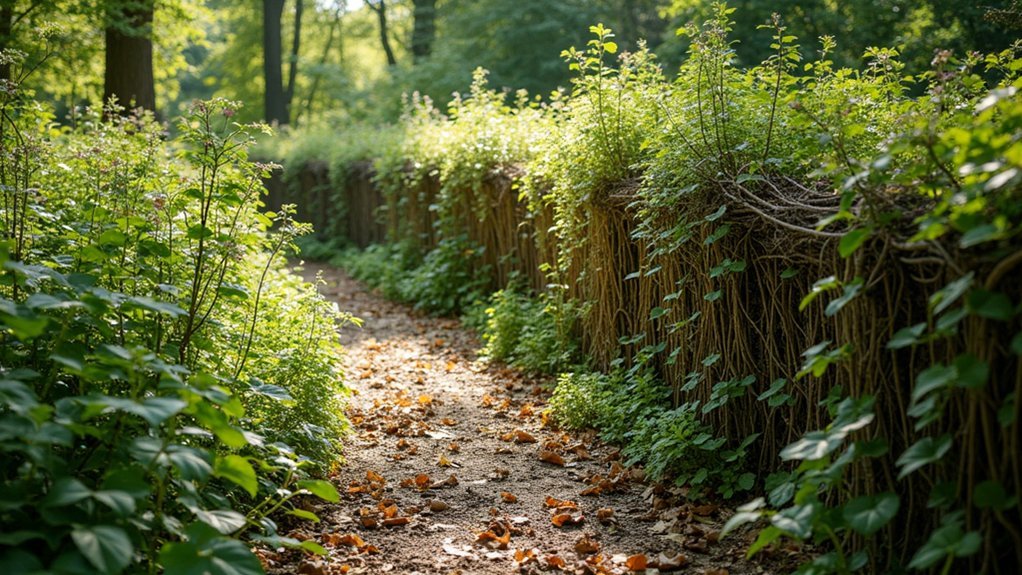
Because they serve as both boundaries and wildlife sanctuaries, living fences require consistent care to fulfill their dual purpose effectively.
Perform regular inspections to identify damaged branches or loose supports that could compromise wildlife habitat quality.
Your maintenance practices should include strategic pruning to encourage dense, bushy growth—creating better cover for wildlife while maintaining the fence’s form.
Don’t neglect seasonal tasks like trimming overgrown sections and removing dead plants to prevent disease spread that could harm the entire boundary.
While establishing your living fence, install protective measures such as guards or temporary fencing to shield young plants from browsing animals.
Consider repurposing prunings as mulch or fodder, creating a sustainable maintenance cycle that enhances soil health while reducing waste—supporting both your fence and the creatures that call it home.
Balancing Privacy Needs With Wildlife Accessibility
While creating a secure boundary for your property remains essential, your living fence can simultaneously serve as a wildlife corridor when properly designed.
You’ll enjoy privacy without isolating your landscape from the natural ecosystem. Layer dense native shrubs beneath taller trees to create concealment while maintaining habitat connectivity.
- Incorporate strategic gaps in lower fence sections to allow small animals passage while maintaining your privacy.
- Select varied plant heights, mixing evergreens for year-round screening with flowering shrubs for seasonal interest.
- Choose wildlife-friendly materials like post-and-rail designs when structural elements are needed.
- Maintain regularly through thoughtful pruning to guarantee your living fence remains effective for both privacy and wildlife.
This balanced approach creates boundaries that respect both human needs and ecological connections.
Creating Corridors: Connecting Fragmented Habitats Through Fencing
As habitat fragmentation increasingly threatens biodiversity across landscapes, your living fence can serve an essential ecological function beyond property boundaries. By strategically designing your fence as a wildlife corridor, you’ll provide vital pathways that can boost biodiversity by up to 75%.
| Corridor Element | Wildlife Benefit |
|---|---|
| Native plants | Food sources and shelter |
| Varied vegetation heights | Habitat for diverse species |
| Dense understory | Protection from predators |
| Flowering species | Support for pollinators |
| Gaps or passages | Movement for larger mammals |
Incorporate a mix of shrubs, vines, and trees in your living fence design to maximize ecological connectivity. This structure helps wildlife access indispensable resources while maintaining genetic diversity within populations. Your thoughtful corridor can transform isolated habitats into a connected network that supports the natural movement patterns wildlife desperately needs.
Case Studies: Successful Living Fence Transformations
You’ll find inspiration in the suburban restoration project where homeowners replaced their chain-link fence with native elderberry shrubs, creating a vibrant wildlife sanctuary that tripled local bird visits.
Community efforts in Milwaukee transformed concrete barriers into flowering corridors that now connect previously isolated green spaces, allowing urban wildlife to move freely throughout the city.
Perhaps most impressive is the Johnson family farm’s conversion of traditional barbed wire boundaries to mixed hedgerows, which now serves as a passage zone between agricultural land and the adjacent forest preserve.
Suburban Garden Restoration
Three remarkable case studies demonstrate how living fences have transformed suburban landscapes across the country.
These restorations showcase how homeowners have successfully replaced traditional fencing with diverse native plants that serve multiple ecological functions while enhancing property aesthetics.
You’ll find several advantages when restoring your garden with living fences:
- Enhanced biodiversity – Creates habitats for birds, pollinators, and other wildlife
- Natural protection – Reduces noise pollution while acting as barriers against pests and erosion
- Seasonal benefits – Provides food sources through flowering shrubs and fruiting species
- Lower maintenance – Requires less upkeep than conventional fencing options
For ideal results, plan your restoration during summer for fall planting, giving your living fence time to establish before winter arrives.
Urban Corridor Creation
While suburban gardens showcase impressive biodiversity gains, urban corridors created through living fences represent even more remarkable transformations.
Cities like Chicago have revitalized neglected alleyways into thriving wildlife habitats by installing native plants that connect fragmented ecosystems. In San Francisco, community initiatives have used living fences to combat urban heat islands while creating shaded pathways that benefit both residents and wildlife.
Toronto’s living fence projects demonstrate measurable success with a 30% increase in bird populations and reduced noise pollution.
Similarly, Portland’s green infrastructure utilizes these natural barriers to improve soil permeability and manage stormwater runoff effectively.
You’ll find these urban corridor creations don’t just beautify concrete landscapes—they’re functional ecosystems that restore biodiversity while providing essential services from air purification to wildlife movement support across previously disconnected urban spaces.
Farm-to-Forest Conversion
Transforming traditional farm boundaries into living fences has yielded remarkable ecological and economic benefits across diverse agricultural landscapes.
You’ll find these natural barriers not only serve functional purposes but also create thriving wildlife corridors that connect fragmented habitats.
- Midwest Success: Farms using native viburnum and elderberry living fences have seen crop yields increase by 30% through improved pollinator attraction.
- Pacific Northwest Innovation: Mixed willow and blackberry living fences reduced soil erosion by 40% while enhancing water retention.
- Pest Management: Thorny species like black locust in living fences have cut rodent populations by half while supporting biodiversity.
- Economic Advantage: New England farmers report 60% lower maintenance costs over five years compared to traditional fencing methods.
Resources for Sourcing Native Plants and Support
Once you’ve decided to establish a living fence, finding the right native plants becomes your next essential step. The Native Plant Finder is a valuable tool to identify species best suited for your region’s unique conditions.
| Resource Type | Where to Find | Benefits | Best For |
|---|---|---|---|
| Local Nurseries | Your community | Healthy, adapted plants | Direct guidance |
| Conservation Groups | Community centers | Expert advice, workshops | Learning techniques |
| Online Databases | Internet | Wide selection variety | Rare native plants |
| Community Events | Botanical gardens | Networking, plant sales | Building connections |
Don’t overlook the value of connecting with local gardening clubs that often host native plant sales and educational sessions. These community resources can provide practical support while you transform your property boundary into a thriving wildlife corridor.
Frequently Asked Questions
What Are the Disadvantages of Live Fences?
You’ll face significant effort establishing living fences – they require intensive labor, protection during growth, regular pruning, and develop slowly. You’re also limited by plant species availability in your region.
What Is the Best Fence to Keep Wild Animals Out?
You’ll find smooth wire fencing most effective for keeping wild animals out. It prevents injuries and can be designed with appropriate heights and gaps to deter larger wildlife while allowing smaller creatures to pass safely.
What Is the Spacing for Wildlife Friendly Fence?
For wildlife-friendly fences, you’ll want to space shrubs 3-5 feet apart, trees 8-12 feet apart, and vines about 6 feet apart. For denser wildlife cover, you can place shrubs closer at 2-3 feet.
What Is the Best Species for a Living Fence?
For a living fence, you’ll find Osage orange ideal due to its drought resistance and thorns. You can also choose jujube for edible fruit or tagasaste for nitrogen-fixing benefits. Mixed species provide the greatest wildlife value.
In Summary
By installing a living fence, you’ve created more than just a boundary—you’ve established a thriving ecosystem that connects fragmented habitats while meeting your privacy needs. You’re now part of a centuries-old tradition that’s fighting habitat loss. Don’t stop here—continue learning, adapting your design, and watching as wildlife makes your living border their home. You’re making a difference with every plant you add.
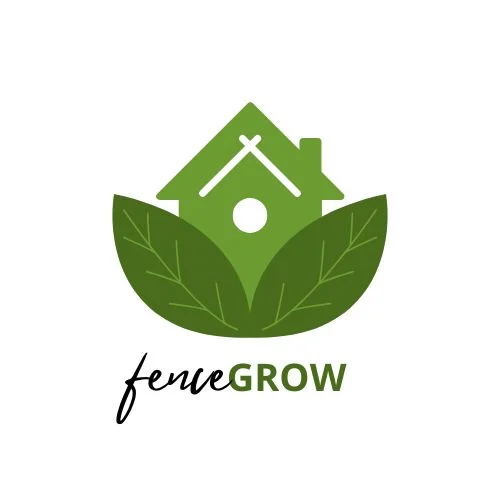


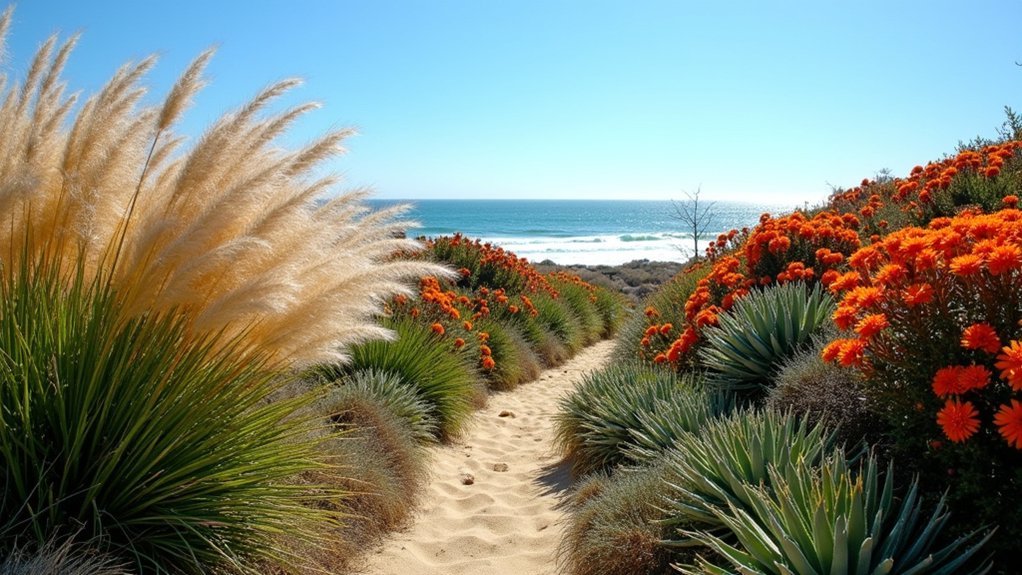
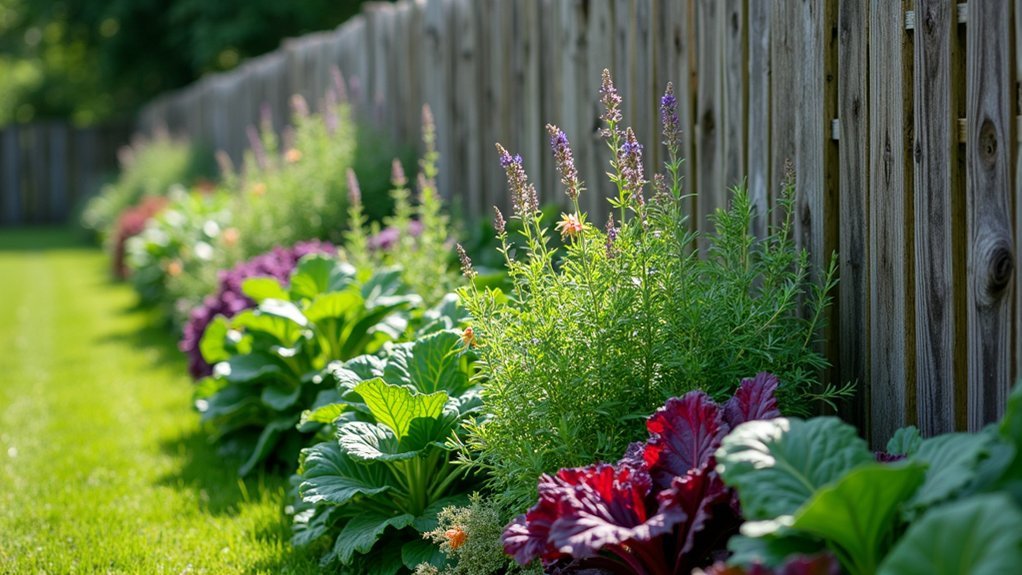
Leave a Reply